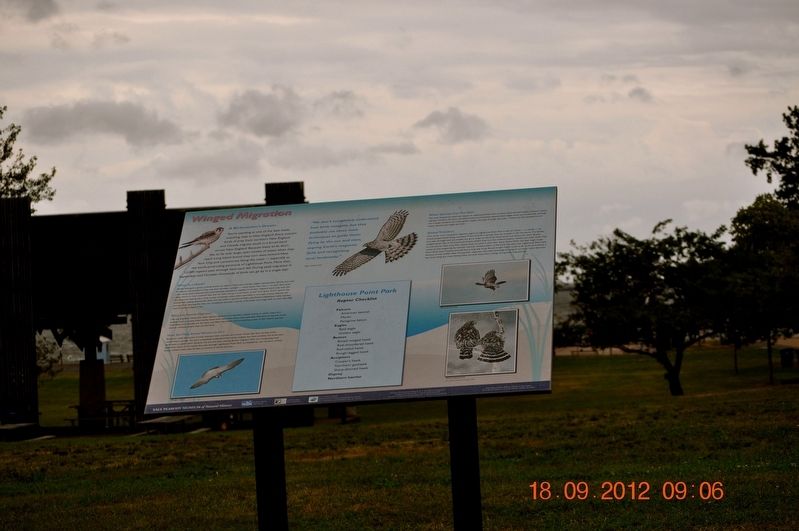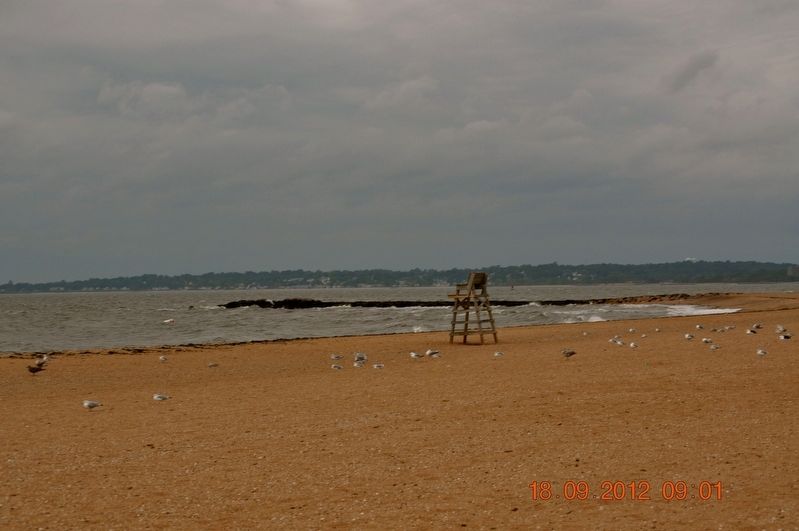Winged Migration
A Birdwatcher’s Dream
You’re standing at one of the best hawk-watching sites in New England. Every autumn birds of prey from Northern New England and Canada migrate south in a broad band across New England. Because theses birds don’t like to fly over large, open bodies of water, when they reach Long Island Sound they turn west, toward New York City, and concentrate along the coast-especially at the south-protruding peninsula of Lighthouse Point. More than 12,000 raptors pass through here each fall. During peak migration in September and October, thousands of birds can go by in a single day!
What is a Hawk?
Hawks belong to a group of birds known as raptors, which includes eagles, ospreys, kites, falcons and owls. All raptors are predators. They use their excellent eyesight-much better than ours-to spot their prey, other birds, small mammals, fish, invertebrates, amphibians, reptiles, or carrion. Raptors catch prey with the sharp talons on their powerful feet and use their strong curved beaks to tear food apart. Some raptors, like American kestrel, eat a wide variety of animals, while others specialize in one type of prey. Ospreys eat mostly fish, making spectacular dives into the water in pursuit of their prey. Several adaptations make ospreys very good at catching fish: they can completely seal their
Why do Hawks Migrate?
Like any predator: hawks and the raptors depend on an abundant supply of prey. In winter there isn’t enough food to sustain many hawks. Some prey types like many small mammals, hibernate during the winter. Amphibians and reptiles are dormant, and takes many freeze over, preventing access to fish. Hawks head for warmer climates where they can find food.
How Do They Know Where to Go?
Birds can travel thousands of miles between their summer and winter homes. But how do they know where they’re gong? We don’t completely understand how birds navigate, but they probably use three main techniques to guide them: flying but the sun and stars, sensing Earth’s magnetic fields and recognizing local landmarks. Some of the hawks that pass through Lighthouse Point Park are headed for the southeast United States. Others travel even farther to Central or South America.
“We don’t completely understand how birds navigate, but they probably use three main techniques to guide them: flying but the sun and stars, sensing Earth’s magnetic fields and recognizing local landmarks.”
Right: Cooper’s Hawk
Lighthouse Point Park
Raptor Checklist
Falcons
American kestrel
Merlin
Peregrine falcon
Eagles
Bald
Golden eagles
Buteos
Broad-winged hawk
Red-shouldered hawk
Red-tailed hawk
Rough-legged hawk
Accipiters
Cooper’s hawk
Northern goshawk
Sharp-shinned hawk
Osprey
Northern harrier
What Species Can You See?
The most frequently observed raptors at Lighthouse Point Park, include sharp-shinned hawks, Cooper’s hawks, ospreys northern harriers, red-tailed hawks, and American kestrels. Bald eagles show up consistently, although not in large numbers, and a few golden eagles also pass through each year. Check out the complete list of raptor species you might see here.
Global Travelers
One of the most impressive migration sights at Lighthouse Point Park is that of a flock-or-kettle-of-broad-winged hawks flying overhead. These birds fly in groups that can number in the thousands. The kettles that pass through here are smaller, but grow larger as the birds travel south and others join them. Broad-winged hawks nest in Connecticut’s forests, where they can hunt, for rodents insects, reptiles and other birds. They sit and wait for their prey then swoop down to catch it with their sharp talons. When the days begin to get cooler, broad-winged hawks head for warmer climates. Some of the birds that pass over lighthouse Point have flown down from Canada
Erected by Yale Peabody Museum of Natural History.
Topics and series. This historical marker is listed in these topic lists: Animals • Environment • Horticulture & Forestry. In addition, it is included in the Lighthouses series list.
Location. 41° 14.934′ N, 72° 54.213′ W. Marker is in New Haven, Connecticut, in New Haven County. It is in East Shore. Marker is on Lighthouse Road. Marker is located at Lighthouse Point Park. Touch for map. Marker is at or near this postal address: 2 Lighthouse Road, East Haven CT 06512, United States of America. Touch for directions.
Other nearby markers. At least 8 other markers are within 2 miles of this marker, measured as the crow flies. The Butterfly Garden at Lighthouse Point Park (here, next to this marker); How Can I Help the Sound? (here, next to this marker); So Who Lives Here, Anyway? (here, next to this marker); Near This Spot (within shouting distance of this marker); Roll of Honor (approx. one mile away); In Memory of George Pardee (approx. 1.1 miles away); Fort Nathan Hale (approx. 1½ miles away); Patriots of New Haven Memorial (approx. 1½ miles away). Touch for a list and map of all markers in New Haven.
Credits. This page was last revised on February 10, 2023. It was originally submitted on August 22, 2017, by Sandra Hughes Tidwell of Killen, Alabama, USA. This page has been viewed 250 times since then and 8 times this year. Photos: 1, 2. submitted on August 22, 2017, by Sandra Hughes Tidwell of Killen, Alabama, USA. • Bill Pfingsten was the editor who published this page.

